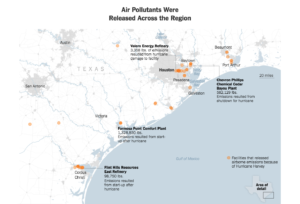
The above image is from Pine Bend Refinery in Rosemount, Minnesota
Retrieved from: pinebendrefinery.com
The Minnesota Environmental Partnership is proud to feature the following post as part of a series of columns as part of a Student Voices Series issues. This is part of a continuing collaboration with Macalester College’s Geography Department and its students.
Contribued by Ariana Jahiel, Macalester Student:
On September 8th, the New York Times released an article entitled, “More Than 40 Sites Released Hazardous Pollutants Because of Hurricane Harvey.” At first glance, it is easy for us here in Minnesota to skim over this report and write it off as irrelevant due to our geographic location. But the truth is climate change-induced natural disasters impact Minnesota, too. Flooding and tornados are not uncommon in this state, and such storms are likely to increase in frequency and severity. And like Texas, Minnesota is also home to oil refineries, one of which, the Pine Bend Refinery located just outside the Twin Cities, is the largest of all oil refineries located in non-oil-producing states, according to the U.S. Energy Information Administration.
So what type of toxic exposure actually happened? And why? Over 1.5 million pounds of toxic pollution was released into the air by fossil fuel-producing companies including, but not limited to ExxonMobil, Petrobras, Shell, and Chevron Phillips Chemical. In the face of an imminent natural disaster, oil refining and petrochemical facilities are often forced to make the choice to temporarily shut down due to environmental conditions. According to the Environmental Defense Fund (EDF), when an industrial facility decides to stop running, especially when the decision is made last minute, emissions will increase, possibly to an illegal level as was the case in Texas. Large amounts of pollution are also released when plants start up again after a closure. Making matters worse, the EDF states that many of these facilities use out-of-date technology, inefficient design, and poor training techniques, all of which act to magnify the problem.
As more and more of these climate change-induced natural disasters occur, it becomes even more critical that there be stricter standards to which all facilities must adhere. These standards work to avert these types of preventable environmental harms from adding to an already dire situation. Although there are state and federal protocols already in place to curb the effects of hurricanes on these facilities, they are clearly not enough; they have not prevented the 1.5 million pounds of pollutants from entering the atmosphere, ground, and water. When a storm hits, there are enough concerns for people who cannot evacuate; they should not have to worry about whether or not drinking water and the air they breathe has been contaminated with toxic chemicals.

The above map shows the location of plants that released hazardous emissions due to Hurricane Harvey. Image retrieved from: NY Times
What does this mean for the future? First, it is important that we recognize that Hurricanes Harvey, Irma, and Maria are not merely flukes. Global warming has raised the temperature of ocean waters, fueling the unprecedented fury of these storms. Climate change is real, and so are its consequences. These hurricanes are indications of what is yet to come.
We can’t let industries continue their lax protocol and profit-driven negligence. At the bare minimum, refineries and other like facilities must function using the precautionary principle, the idea that the possible harmful impacts of a given situation present a social responsibility to protect public from these potential outcomes. Thus, industries must shut down enough in advance of the natural disaster so as to prevent large amounts of pollution entering our environment. Additionally, these events mean that the pollution-control devices are not well designed or sufficiently up to date so as to protect citizens or the environment from harmful toxins. According to Luke Metzger, the director of Environment Texas, all pollution-control devices must be renovated and meet more stringent standards.
Perhaps most importantly, these events mean that citizens must demand intense regulation from our governmental bodies. This is particularly important in this time when the US Environmental Protection Agency and the Trump Administration more generally are trying to deregulate and leave decision-making to the corporations themselves. Thus, we cannot look to our national government to meet our demands for a safer and healthier state. But we can and should demand of our state institutions to uphold such measure.
We must put pressure on the Minnesota Environmental Quality Board, the Minnesota Pollution Control Agency, and the Minnesota Department of Health to enact safer regulations on industrial facilities in Minnesota. Additionally, we as Minnesotans must pursue with rigor our current commitment to reducing our dependence on fossil fuels and increasing our use of renewable energy. We cannot back off this trajectory.